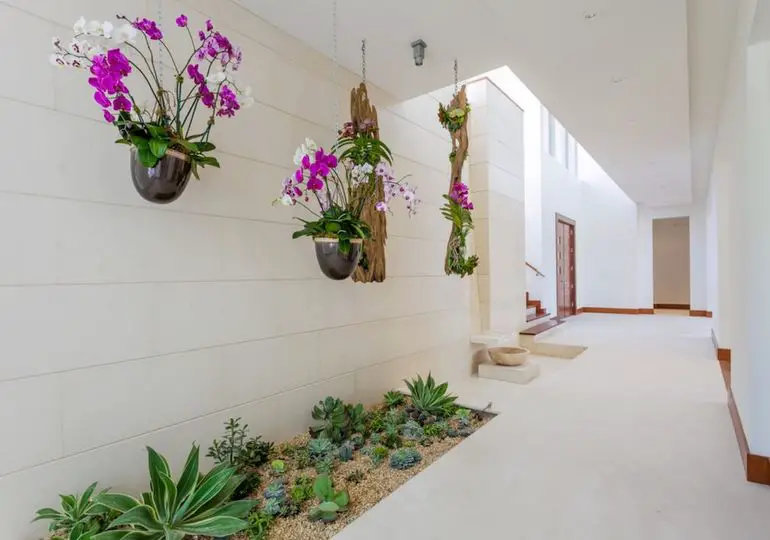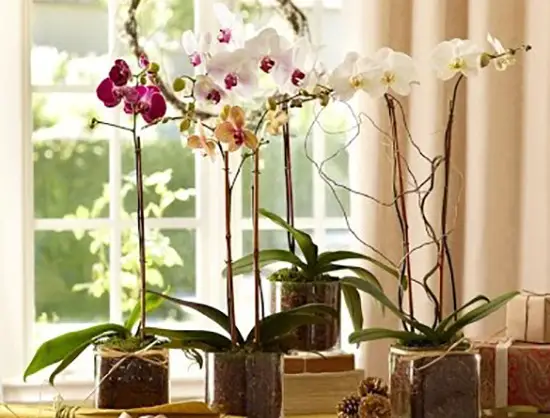Very often, the wrong location negates all the efforts of the grower to care for the plant. The orchid very quickly makes it clear to its owner that it is not comfortable. If despite proper care, the growth of the plant stops, the leaves turn yellow and wrinkle, the roots are covered with mucus, and there are no hints of flowering, then you should find your favorite a more suitable place. Here we will show you where to put orchids in your home.

Indoor Orchid Keeping Rules
The choice of a permanent place for the growth of orchids in the house should be based on the observance of the basic conditions of keeping, as close as possible to natural :
- enough sunlight;
- constant access to fresh air;
- protection against drafts;
- compliance with the temperature regime, excluding overheating and hypothermia;
- maintaining optimum air humidity.
It is very important to ensure the daily temperature fluctuation. The difference between day and night values for most orchid species should be at least 5°C.
| Period | Temperature range In afternoon | Temperature range At night | Minimum Limit | Maximum Limit |
|---|---|---|---|---|
| October to February | +18-22°C | +15-18°C | +12°C | +32°C |
| March to September | +20-26°C | +18-20°C |
In the summer, the temperature difference during the day is easy to ensure by placing the orchid in fresh air in a place protected from drafts and precipitation. This could be:
- glazed balcony;
- loggia;
- garden gazebo;
- terrace or veranda.
You can simply open the window at night, having previously protected the plant from a draft.
Take a look at watering orchids after repotting.
Where To Put Orchids In Your Home
An ideal place for keeping orchids is a heated loggia with double glazing or an orchidarium (special greenhouse). But for most ordinary orchid lovers, this is the ultimate dream. Usually, a window sill is chosen for the dislocation of indoor plants at home.
Undoubtedly, the best place to find most orchid species in a typical city apartment is the windowsill. Here, it is easiest to comply with the main condition for their normal life – access to sunlight. Of course, the intensity of the illumination must be adjusted for the biological characteristics of the particular species. So, Phalaenopsis will feel great on the north side. And Dendrobiums, Cattleyas, Wands will require additional lighting here even in summer. It is also necessary to make allowances for the degree of illumination of the window itself. It happens that through the south window, closed from the sun by the canopy of the balcony or by the dense crown of a tree growing nearby, much less light penetrates than through a window oriented to the north.
Here if you are love of cattleya orchid How To Propagate Cattleya Orchids?
Best Window Facing for Orchids Placement
| Window orientation | Autumn winter Period | Spring Summer Period |
|---|---|---|
| South side | Suitable for all types of orchids | Requires shading at midday;dangerous for plants with overdried substrate |
| North side | Requires the organization of artificial lighting up to 10-12-hour daylight hours | Illumination is required for 1-2 hours a day |
| West side | Illumination is required for 1-2 hours a day | Alternative to south windows, but no shading |
| East side | Suitable for maintaining a resting phase | Suitable for all types of orchids, no shading required |
In short, in winter and autumn, orchids are best kept on the windows of the southern and western exposure, and in spring and summer on the eastern or unshaded northern ones.
What facing window is best for orchids?
South facing window is best for orchids placement. The orchid south facing window protect from the scorching summer sun with blinds, roller shutters, light transparent curtains.

Where should orchids be placed indoors in winter?
Important! In winter, almost all orchids, even those in the dormant phase, require additional lighting with a special phyto-lamp or at least a fluorescent lamp. If the plants hibernate far from the window, then the artificial light source should work almost all day – at least 10-12 hours. For orchids living on the windowsill, the lamp is turned on at dusk.
Tip # 1: To ensure a certain rhythm of artificial lighting, it is recommended to purchase a lamp with a timer that will turn on and off automatically according to the specified mode.
To provide the coolness required for the rest period, it is advisable to fence off the edge of the window sill with a high side that protects the orchids from the action of heating radiators. You will end up with something like an aquarium with the desired microclimate and a temperature of 3-4°C lower than in the rest of the room.
Places Bad for Orchids Placement indoor
It is strongly not recommended to place an orchid:
- near heating radiators;
- under an open window;
- on a narrow window sill, where the leaves of the plant are in contact with cold glass;
- within the radius of the air conditioner;
- in the immediate vicinity of devices with electromagnetic radiation (microwave ovens, computers, televisions, etc.).
You may like Indoor orchid care for beginners.
what to do with sunburned orchid leaves?
It is not worth cutting out the spots formed as a result of the burn, and even more so to remove the burnt leaves. It must be borne in mind that the negative consequences of excessive insolation are the more serious, the drier the substrate in which the orchid grows. Therefore, the first step is to moisten the soil. It is advisable to soak the container with the plant for 1-2 hours in a solution of “Zircon” (5 drops of the drug per 1 liter of water).
